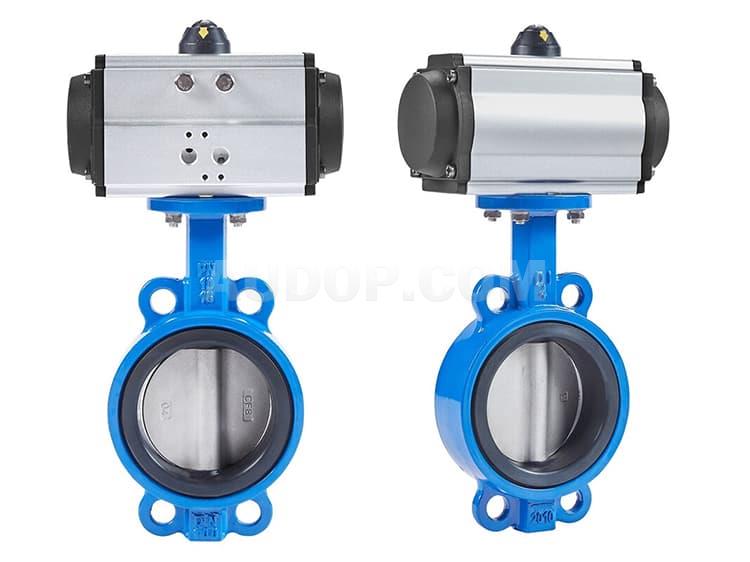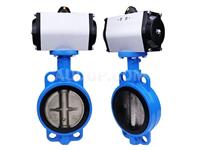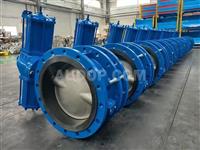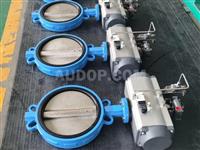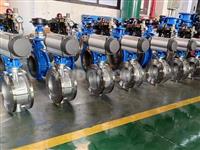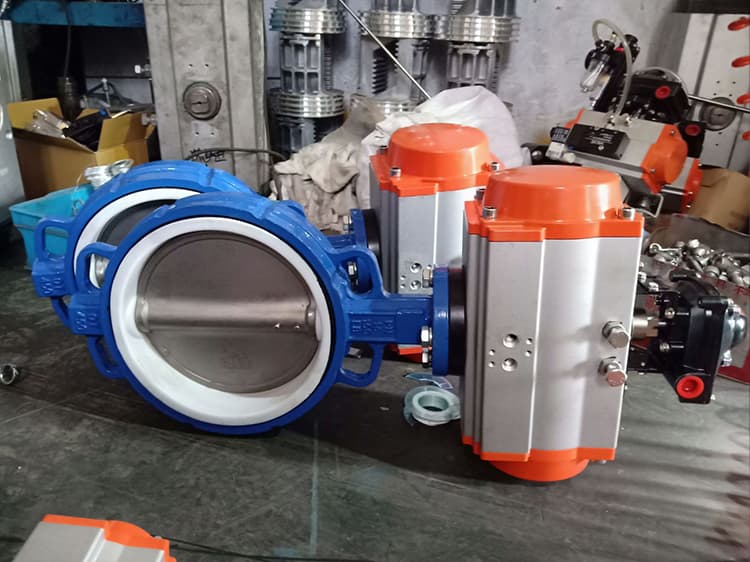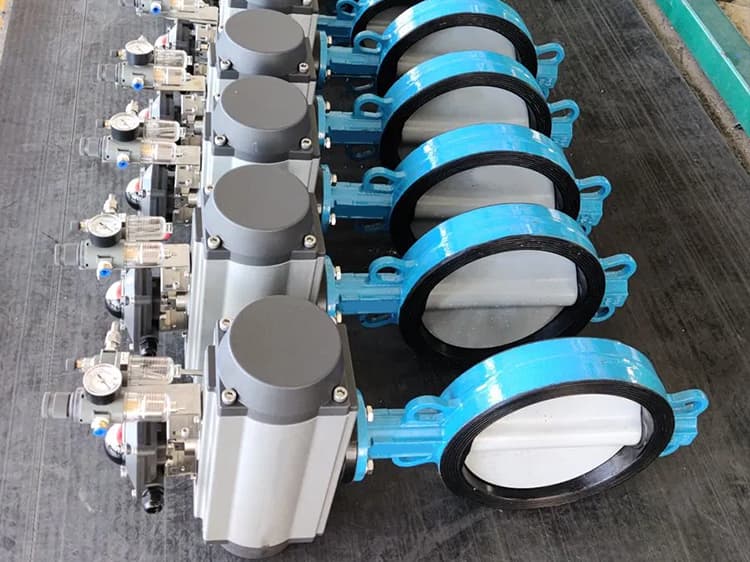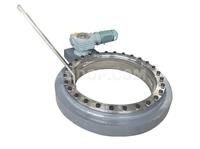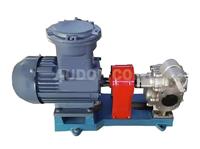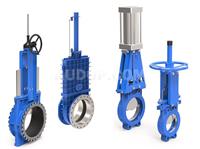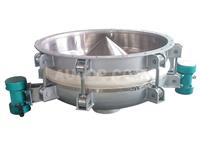Pneumatic Butterfly Valve
- Fast Response: Pneumatic butterfly valves have a fast opening and closing speed, which can quickly respond to control commands. They are suitable for occasions that require rapid fluid regulation, improving the responsiveness of industrial control systems.
- Simple Structure: Pneumatic butterfly valves have a simple design structure, small size, and light weight. They are suitable for use in narrow spaces, reducing installation space requirements for industrial pipelines.
- Low Cost: Compared with other types of valves, pneumatic butterfly valves have lower manufacturing costs, making them suitable for large-scale applications. This cost advantage helps enterprises reduce equipment investment.
- Easy Maintenance: Due to their simple structure, pneumatic butterfly valves are relatively easy to maintain, reducing production downtime. This helps improve the overall operational efficiency of industrial production lines.
- Precise Flow Regulation: The opening degree of pneumatic butterfly valves can be adjusted through air pressure, realizing precise regulation of flow rate. This feature meets the strict flow control needs of various industrial processes.
Overview
A pneumatic butterfly valve is a device that uses a pneumatic actuator to control the opening and closing of the valve, mainly used for regulating the flow rate and direction of fluids in pipelines. It is a core component in industrial fluid control systems.As a type of butterfly valve in the valve family, its key feature is a circular valve disc, which can control the fluid in the pipeline through rotation. This structural design ensures efficient fluid regulation.Combining the structural characteristics of butterfly valves with pneumatic actuators, pneumatic butterfly valves are usually applied in scenarios requiring automatic control, such as large-scale fluid conveying systems. They are particularly suitable for flow regulation and cut-off control of media like gas, liquid, and steam.Due to advantages such as small size, light weight, excellent sealing performance, fast opening/closing speed, and simple operation, pneumatic butterfly valves are widely used in various industrial fields including petroleum, chemical engineering, metallurgy, power generation, and water treatment.A pneumatic butterfly valve is a control terminal installed on industrial pipelines. Similar to electric butterfly valves, it belongs to the category of automatic control valves, providing reliable control for industrial processes.Nowadays, pneumatic butterfly valves are widely used in industries such as petroleum, chemical engineering, power generation, and metallurgy. They are often applied in pipeline environments of these industries where manual operation is not suitable, enhancing operational safety and efficiency.A pneumatic butterfly valve consists of a pneumatic actuator and a butterfly valve. These two components work together to ensure stable and efficient fluid control.Using compressed air as the power source, a pneumatic butterfly valve controls the rotation of the valve disc around the axis through the valve stem. When the valve rotates 90° from its initial position, one action cycle is completed (from closed to open), and the reverse rotation completes the other action cycle (from open to closed). This design enables quick switching between on and off states.
Working Principle of Pneumatic Actuated butterfly valve:
The working principle of pneumatic butterfly valves is based on the combination of the basic structure of butterfly valves and pneumatic driving devices. This integration ensures precise and automated fluid control.Inside the valve body of a butterfly valve, there is a circular valve disc, which is connected to the actuator via a valve shaft. This connection enables the transmission of power for valve operation.Pneumatic actuators usually use compressed air as the power source. They drive the rotation of the butterfly valve in the valve's drive system, thereby realizing the opening/closing or flow regulation of the valve. This power transmission method ensures fast response of pneumatic butterfly valves.When compressed air is supplied to the pneumatic actuator, the piston or diaphragm inside the driving device starts to move, and the connected valve shaft drives the valve disc to rotate. This process is smooth and ensures stable valve operation.If the valve disc rotates to a direction perpendicular to the pipeline, the valve closes and the fluid is cut off; when the valve disc is parallel to the pipeline, the valve opens and the fluid flows. This simple yet effective mechanism is a key advantage of pneumatic butterfly valves.The opening and closing time of pneumatic butterfly valves is very fast, usually completing the operation within a few seconds. Therefore, they are very suitable for automated control needs that require quick response, improving the efficiency of industrial production lines.Pneumatic butterfly valves can achieve different degrees of opening control by adjusting air pressure, thereby realizing precise regulation of fluid flow. This function meets the strict flow control requirements of various industrial processes.Therefore, pneumatic butterfly valves are not only suitable for on-off control but also widely used in the field of flow regulation, making them versatile for different industrial applications.
Structural Composition of Pneumatic Butterfly Valves:
- Valve Body: The valve body is the main structural part of a pneumatic butterfly valve, usually made of materials such as cast iron, stainless steel, or aluminum alloy. These materials ensure the valve body's durability and corrosion resistance in harsh industrial environments.A valve seat is installed inside the valve body, used for installing and supporting the valve disc. The valve seat also helps maintain the sealing performance of the valve when it is closed.The valve body is designed to be compact, allowing fluid to flow through the internal flow channel of the valve body. This compact design saves space, making pneumatic butterfly valves suitable for installation in narrow areas.
- Valve Disc: The valve disc is one of the key components in a pneumatic butterfly valve, usually made of high-strength metal or other corrosion-resistant materials. This ensures the valve disc's long service life even when in contact with corrosive media.The valve disc is usually circular and connected to the actuator via a valve shaft. This connection ensures the smooth transmission of rotational force for fluid control.The rotation of the valve disc controls the flow of fluid in the pipeline. The precise rotation angle directly affects the flow rate, making the valve disc a core part of flow regulation for pneumatic butterfly valves.
- Valve Shaft: The valve shaft is a component that connects the valve disc and the pneumatic actuator. It is responsible for transmitting the movement of the actuator to the valve disc, making the valve disc rotate to control the on-off state and flow rate of the fluid. High-quality valve shafts ensure stable power transmission for pneumatic butterfly valves.
- Pneumatic Actuator: The pneumatic actuator is the power source of a pneumatic butterfly valve. It drives the rotation of the valve disc through compressed air. The performance of the actuator directly affects the response speed and torque of the valve.Pneumatic actuators can be of diaphragm type or piston type. The specific selection depends on the required torque and response speed, allowing pneumatic butterfly valves to adapt to different industrial working conditions.
- Sealing Ring: The sealing ring is used to ensure the sealing performance of the valve when it is closed, preventing fluid leakage. Good sealing is essential for maintaining the safety and efficiency of industrial pipeline systems.The material of the sealing ring is usually selected based on the medium, such as PTFE, rubber, etc. This customization ensures that pneumatic butterfly valves can be used with various fluids without leakage.
- Sensors and Control Systems: In modern automated control systems, pneumatic butterfly valves are often equipped with sensors and automated control systems to achieve precise flow regulation and on-off control. This integration makes the valves compatible with intelligent industrial control systems, reducing manual intervention.
Application Scenarios of Flanged Butterfly Valve:
Due to features such as simple structure, convenient operation, and fast response, pneumatic butterfly valves are widely used in various industrial fields. The main application scenarios include:
Chemical Industry: Chemical production requires precise control of various fluids. Pneumatic butterfly valves can handle complex fluid media and provide fast and reliable on-off operations during chemical reactions. They are widely used in equipment such as reaction kettles, pipeline conveying systems, and chemical dosing systems, ensuring the accuracy and safety of chemical processes.
Food and Beverage Industry: In the food processing process, pneumatic butterfly valves are usually used for flow control and conveying of liquid materials. They ensure the precise proportioning of materials, avoid contamination, and guarantee the smooth operation of production lines. The food-grade materials used in the valves meet the hygiene standards of this industry.
HVAC Industry (Air Conditioning and Heating): In air conditioning systems and heating, ventilation, and air conditioning (HVAC) systems, pneumatic butterfly valves are used to adjust air flow and water flow, maintaining the internal balance of the system. Especially in large-scale air conditioning systems, the application of pneumatic butterfly valves is more widespread due to their efficient regulation capabilities.
Installation and Commissioning of Air Actuated Butterfly Valve:
- Before installing and using a pneumatic butterfly valve, the valve body and pneumatic device of the butterfly valve must be thoroughly cleaned. This prevents impurities from affecting the valve's performance and ensures smooth operation.
- Before installation, check whether the valve coating of the pneumatic butterfly valve is damaged. If damage is found, please ask professional personnel to repair it. The intact coating ensures the valve's corrosion resistance and extends its service life.
- Similar to electric butterfly valves, the installation area of pneumatic butterfly valves is generally in working conditions with a certain risk factor. If the valve needs to be moved under such conditions, accidents may occur. At this time, the site must be protected with appropriate covers to ensure the safety of operators.
- The installation position of the solenoid valve should be as close as possible to the actuator cylinder. The size of the air pipe is related to the air capacity. Before installing the pneumatic butterfly valve, it is necessary to ensure that the air inlet and solenoid valve are clean to avoid blockages affecting air supply.The cylinder actuator needs to be filled with lubricating oil. Proper lubrication reduces friction between components and extends the service life of the pneumatic butterfly valve's actuator.
- The opening and closing of the pneumatic butterfly valve should not be too fast to avoid pressure impact on the inside of the valve body and potential dangers. Controlling the switching speed ensures the safe and stable operation of the valve and the entire pipeline system.
Technical Parameters
Technical Parameters
This series of products are highly customized according to the customers' requirements. Therefore, we are unable to provide the procedures and parameters at present. If you are interested in this series of products, please contact us immediately. Audop Company will assign experienced engineers to communicate with you as soon as possible.
Your requirements are the basis for our development and a daily challenge to bring to fruition, please do not hesitate to inquiry us.
Scraper Arch Breaker
- High-Quality Material Guarantee: The main body is made of SUS304 stainless steel, which has stable physical properties. It is not only corrosion-resistant and wear-resistant but also meets the hygiene level requirements of the food and pharmaceutical industries, avoiding contamination when materials come into contact with the equipment. SUS304 stainless steel scraper arch breakers are safe for food-grade applications.
- Simple Structural Design: The overall structure has no complex redundant parts and adopts a "bolt-free" assembly process, reducing gaps for material accumulation and cleaning blind spots. During daily maintenance, there is no need to disassemble complex components; only the scraper wear condition and gear lubrication status need to be checked, which greatly reduces maintenance costs and downtime. Low-maintenance scraper arch breakers save production costs for factories.
- Long Service Life: The core transmission components (gears) adopt precision machining technology, and combined with the wear-resistant treatment of the scraper, mechanical loss during operation is reduced. At the same time, compared with chain transmission, the gear transmission method avoids the risk of chain loosening and breaking, and the average service life of the equipment is more than 30% longer than that of traditional discharging equipment. Long-life scraper arch breakers reduce equipment replacement frequency for manufacturers.
- Significant Arch-Breaking and Wall-Cleaning Effect: The design of the scraper making circular motion along the silo wall can directly act on the retained materials on the side walls and bottom of the silo. It not only solves the "bridging" and "hollowing" problems but also cleans the materials attached to the silo wall, avoiding caking and deterioration caused by long-term material retention and improving material utilization rate. Scraper arch breakers with excellent wall-cleaning function enhance production efficiency.
- Alleviating Material Segregation: For mixed materials with uneven particle sizes, traditional discharging methods are prone to "segregation" (large particles concentrate at the bottom and small particles concentrate at the top) due to different particle settlement speeds, which affects subsequent production quality. The scraper arch breaker keeps the materials in a mixed state during the falling process through the uniform stirring and pushing of the scraper, effectively alleviating the segregation problem. Scraper arch breakers prevent material segregation for consistent product quality.
- Quiet Operation Experience: The gear transmission link adopts a high-precision meshing design, and combined with the lubrication treatment of bearings, the noise during operation is controlled below 60 decibels (equivalent to the volume of daily conversation), avoiding the harsh noise of traditional discharging equipment during operation and improving the workshop working environment. Quiet scraper arch breakers create a comfortable working environment for production line engineers.
- Wide Hopper Angle Adaptability: It can adapt to hopper angles within 45°. Whether it is a vertical silo or an inclined silo, accurate connection can be achieved by adjusting the installation angle, without the need for large-scale modification of the existing silo structure. Scraper arch breakers with flexible hopper angle adaptation fit various silo types.
- Rich Specifications and Customization Options: Standard caliber specifications from φ40 to φ500 are provided, covering different needs from small laboratory equipment to large-scale industrial production lines. For large-caliber needs beyond the standard caliber (such as above φ500), exclusive equipment can be customized through technical consultation according to the customer's silo size and material characteristics, ensuring seamless connection with the existing production system. Customizable scraper arch breakers meet diverse industrial needs for purchasers.
- Expandable Blade Design: It supports the installation of multiple scraper blades (the specific number is determined according to material fluidity and discharging volume). The more blades there are, the higher the discharging efficiency and the more uniform the material stirring, which can be flexibly adjusted according to the actual production rhythm. Expandable blade scraper arch breakers optimize discharging efficiency for different production beats.
KCB Series Gear Pump
- KCB Series Gear Pump is mainly composed of gears, shafts, pump body, relief valve and shaft end seal. The gears undergo heat treatment to achieve high hardness and strength, and are installed in replaceable shaft sleeves together with the shafts for operation. The lubrication of all parts in the KCB Series Gear Pump is automatically achieved by using the output medium when the pump is working.
- The pump is designed with reasonable oil discharge and oil return grooves, which reduce the torque force borne by the gears during operation. As a result, the bearing load is small, wear is minimal, and the KCB gear oil pump has high efficiency.
- KCB Gear Pump is equipped with a relief valve for overload protection. The full return pressure of the relief valve is 1.5 times the rated discharge pressure of the pump. The KCB gear oil pump can also be adjusted separately according to actual needs within the allowable discharge pressure range. However, it should be noted that this relief valve cannot work as a pressure reducing valve for a long time; if necessary, a separate pressure reducing valve can be installed on the pipeline. When viewing the pump from the extended end of the main shaft, the rotation direction is clockwise.
Knife Gate Valve
- Ultra-short structural length saves materials and greatly reduces the overall weight of the pipeline system matched with the knife gate valve.
- It occupies small effective space, effectively supports pipeline strength, and reduces the possibility of pipeline vibration when used with the knife gate valve.
- The gate plate of the knife gate valve is made of austenitic stainless steel, which greatly improves corrosion resistance and effectively prevents sealing leakage caused by gate plate corrosion.
- The upper sealing packing of the knife gate valve adopts flexible PTFE, ensuring reliable sealing and easy, flexible operation.
- The gate plate of the knife gate valve has a knife function, which can effectively cut off various impurities in the medium.
Bin Bottom Vibratory Discharger
- Low power consumption, high efficiency and obvious effect.
- The discharge hopper is integrally stamped, with good rigidity and smooth inner wall. The built-in tapered discharge plate protrudes upward to ensure no material residue in the discharger.
- The vibration force and amplitude can be easily adjusted.
- The fixing bolts of the discharge plate are assembled from top to bottom, which improves safety.
- Low noise generated by vibration, meeting environmental protection requirements.
- Safe and reliable to use, with safety protection devices.
- Simple and novel equipment structure, convenient installation and low maintenance rate.
Roots Blower
- It has the characteristic of forced transportation. Under the condition of a certain rotating speed, the flow rate is basically unchanged. Even in the small flow rate area, surge will not occur, and it has stable working characteristics.
- As a rotary machine, it has no reciprocating mechanism, no air valve, few wearing parts and a long service life.
- It inhales and exhausts air many times in one operation cycle. Compared with the piston compressor, the air flow speed is uniform and there is no air storage tank.
- There is a certain gap between the moving parts and the static parts, and no lubricating oil is needed in the chamber, which ensures that the transported gas is oil-free and no oil-gas separation device is required.
- There is no internal compression process, and the mechanical efficiency is high.
